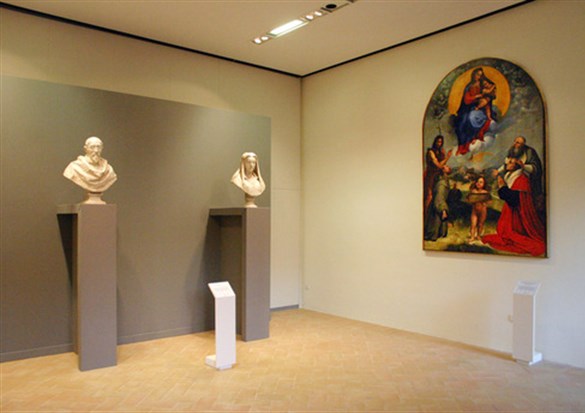
Museo Capitolare Diocesano

ll Museo Capitolare Diocesano di Foligno ha sede nel Palazzo delle Canoniche vicino alla Cattedrale di San Feliciano.
Entrando da Largo Carducci, accanto alla facciata principale del Duomo, sarà possibile osservare le maestose strutture della torre campanaria, del Palazzo delle Canoniche e della Cattedrale stessa, alla base della quale è situato il bookshop con la biglietteria. Una suggestiva scalinata conduce al primo piano, che ospita mostre temporanee, e al secondo, vero cuore della raccolta.
Fa gli “onori di casa” la quattrocentesca statua di San Feliciano, recentemente recuperata e inserita in un percorso che, attraverso varie opere, attraversa le fasi costruttive della Cattedrale, dall’edificio romanico a quello rinascimentale, barocco, e infine neoclassico. Fanno parte di questo primo nucleo museale anche alcune opere del lascito della famiglia Roscioli, che serviva a Roma Urbano VIII e lasciò in eredità alla Cattedrale un’ingente raccolta di opere d’arte, tra le quali anche due busti del Bernini. Il percorso prosegue con l’esposizione di opere di diversa provenienza: per lo più sono presenti manufatti trasportati da chiese in ricostruzione post-sismica, come la sorprendente Bottega di San Giuseppe, attribuita ad ambienti nordeuropei del Cinque-Seicento e da sempre custodita a Serrone. L’ultima parte conserva alcune antiche croci astili, una meravigliosa stauroteca (reliquiario della Vera Croce) trecentesca in cristallo di rocca e parte della preziosa argenteria della Cattedrale. La Cripta di San Feliciano recentemente recuperata fa parte del percorso museale.
Diocesan Chapter Museum
The diocesan chapter museum of Foligno is located in the Palace of canons near the Cathedral of San Feliciano. Entering from Largo Carducci, next to the main façade of the Duomo, it will be possible to observe the majestic structures of the bell tower, the palace of the canons and the Cathedral itself, at the base of which is located the ticket office book shop. A suggestive staircase leads to the first floor, which hosts temporary exhibitions, and to the second, true heart of the collection.Make him "honors of home" the 15th-century statue of San feliciano, recently recovered and inserted in a path that, through various works, crosses the construction phases of the cathedral, from the Romanesque to the Renaissance, Baroque, and finally neoclassical. Part of this first museum nucleus are also some works of the legacy of the Roscioli family, which served in Rome Pope UrbanoVIII and bequeathed to the cathedral a large collection of works of art, including two busts of the Bernini.il path continues with the exhibition of works of different origins: for the most part there are artifacts transported from churches in post-seismic reconstruction, like the surprising Bottega di San Giuseppe, attributed to northern European environments of the sixteenth-seventeenth century and always kept in Serrone.The last part preserves some ancient astili crosses, a wonderful 14th-century staurotheque (reliquary of the true Cross) in rock crystal and part of the precious silverware of the cathedral.The Crypt of San Feliciano recently recovered by the museum route.
ATTUALMENTE IL MUSEO è CHIUSO
Orario di apertura:
INGRESSO SU PRENOTAZIONE e INFO
museodiocesano@diocesidifoligno.it
0742.351209
Biglietti:
ingresso unico €4,00